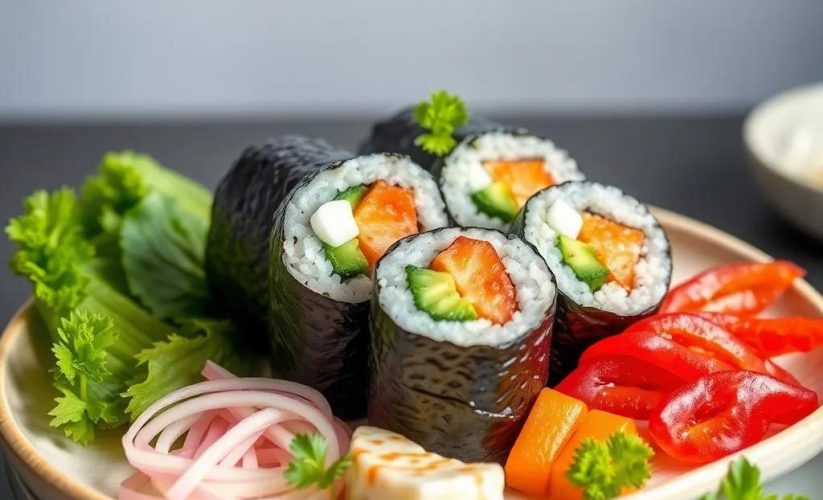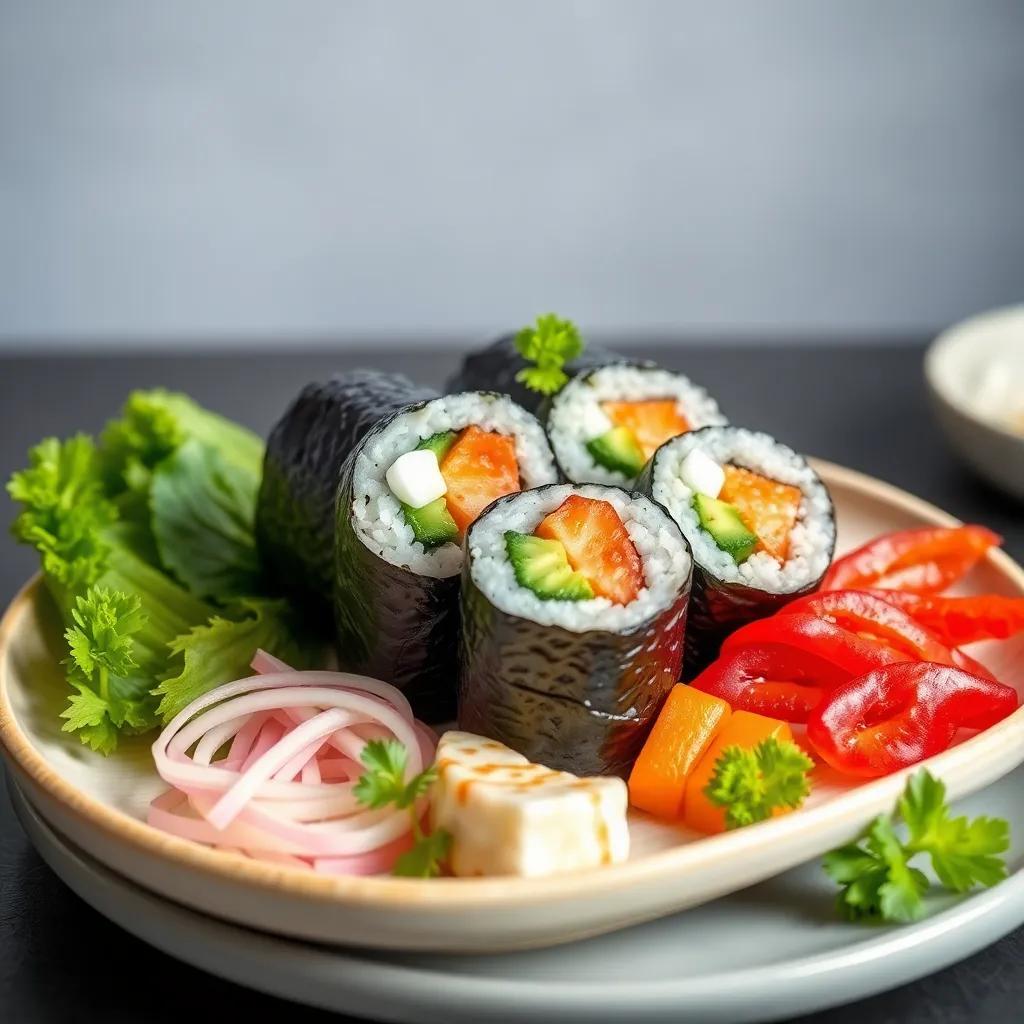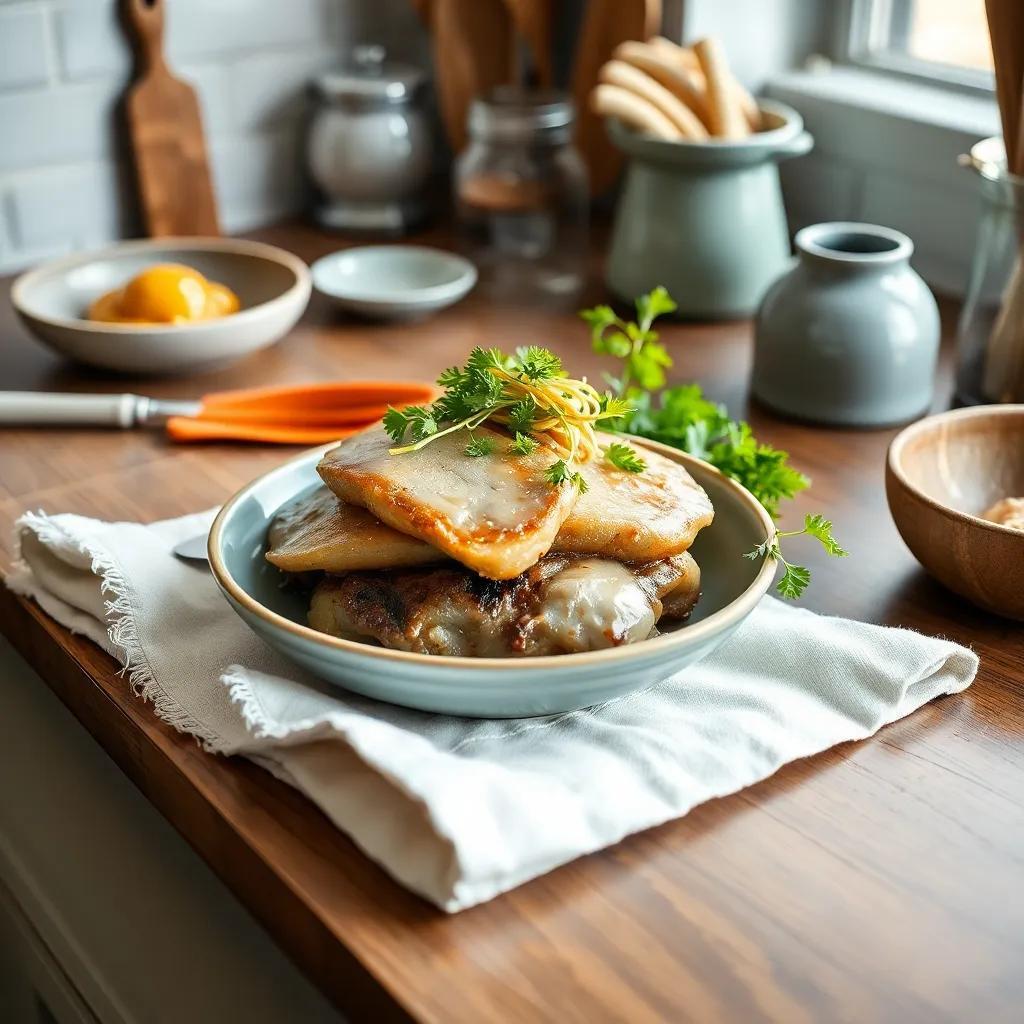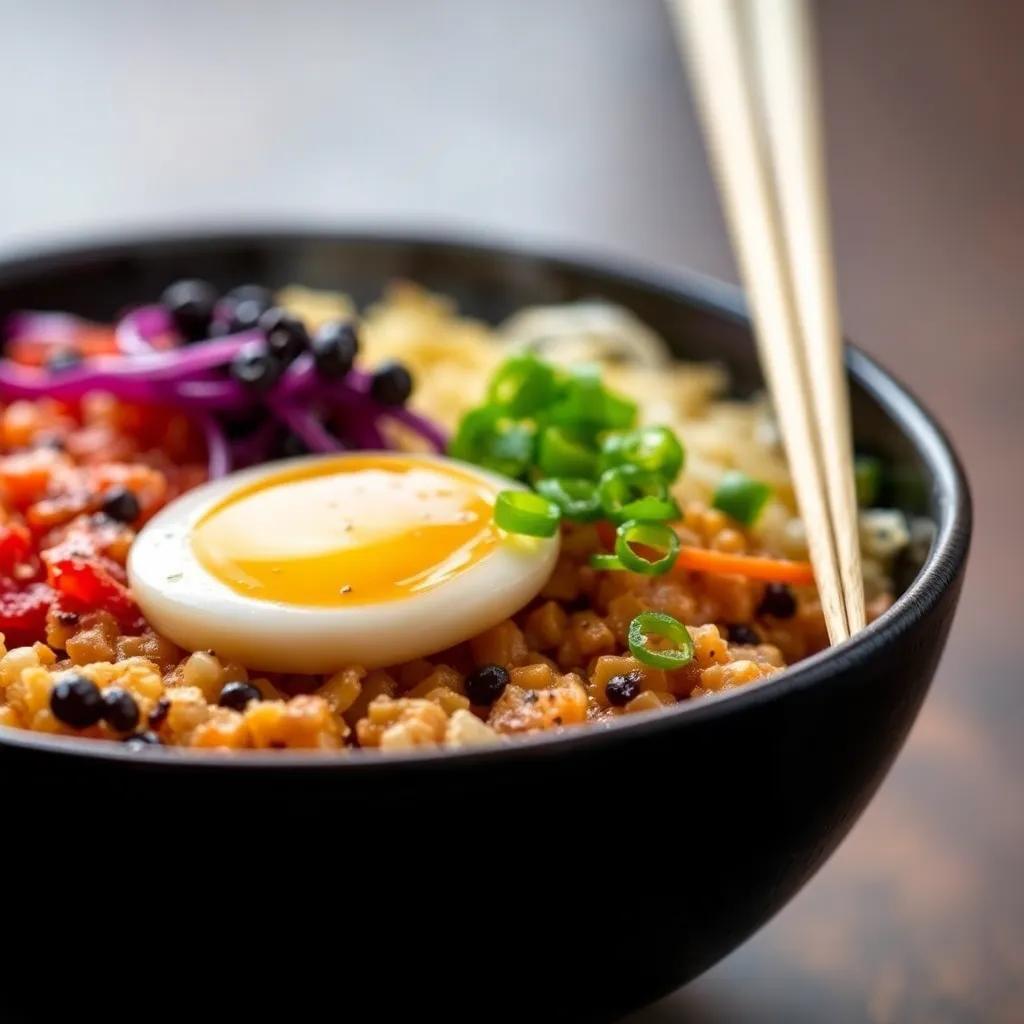Crispy Korean Fried Chicken Recipe: Perfectly Juicy & Easy Guide
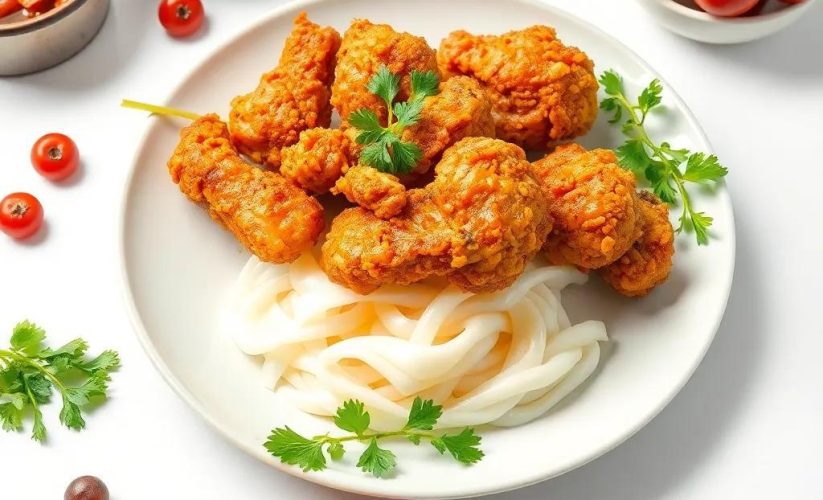
Crispy Korean Fried Chicken Recipe: Perfectly Juicy & Easy Guide
🌍 Cuisine: Korean
⚙️ Difficulty: Medium
Ingredients
Nutrition Facts
520 kcal
Instructions
- Prepare the chicken wings or drumettes by patting them dry with paper towels.
- In a large bowl, whisk together all-purpose flour, cornstarch, baking powder, salt, and black pepper.
- In a separate bowl, beat the eggs with cold water until combined.
- Dip each chicken piece into the egg mixture, then dredge well in the flour mixture to coat evenly. For crispier texture, double dredge by repeating the egg wash and flour coating.
- Heat vegetable oil in a deep fryer or large pot to 340°F (170°C). Fry the chicken pieces in batches for about 6–7 minutes until they are cooked through but pale. Remove and drain on a wire rack or paper towels.
- Increase the oil temperature to 375°F (190°C). Fry the chicken a second time for 2–3 minutes until golden brown and super crispy. Drain again.
- While frying, prepare the sauce: In a small saucepan, combine minced garlic, gochujang, soy sauce, honey, rice vinegar, sesame oil, and brown sugar. Simmer on medium-low heat for 3–4 minutes until thickened slightly. Stir frequently to avoid burning.
- Toss the double-fried chicken in the hot sauce until fully coated and sticky.
- Transfer to a serving platter and garnish with toasted sesame seeds and chopped green onions.
- Serve immediately for best crispiness and flavor.
Serving Suggestions
- Serve with steamed white rice or sticky rice for a complete meal.
- Offer pickled radish cubes (danmuji) on the side for a refreshing contrast.
- Pair with a cold Korean beer or a crisp lager for an authentic experience.
- Serve alongside a fresh cucumber salad with vinegar dressing to cut through the richness.
- Add a side of kimchi to enhance the Korean flavors.
- Use the chicken as a filling for spicy bao buns or rice paper wraps.
- Drizzle extra sauce on top and sprinkle chopped peanuts for added texture.
Table of Contents

Intro
Korean fried chicken has taken the culinary world by storm, and it’s easy to see why. This recipe offers a delightful balance of crispy, crunchy exterior and moist, flavorful meat inside—a combination that keeps you reaching for one more piece. What makes it especially appealing is how approachable it is for home cooks who want to replicate that signature double-fried texture and vibrant sauce without feeling overwhelmed. Whether you’re planning a casual weekend dinner, a game day feast, or a fun party appetizer, this recipe fits effortlessly into any occasion where comfort food and bold flavors are welcome guests.
Making Korean fried chicken at home also invites a bit of culinary creativity and ritual. The process of double frying adds that satisfying crunch that can rival your favorite takeout spots. Simultaneously, tossing the chicken in a sticky, tangy sauce reveals layers of sweet heat and umami, offering a flavor profile that’s exciting but not intimidating. This accessible guide walks you through the steps in an easy-to-follow way, helping you enjoy the experience just as much as the end result.
Beyond the mouthwatering taste and textures, this dish brings people together. Picture sharing a platter of golden, glistening wings surrounded by friends or family, dipping into cool beverages, and savoring each bite. Its balance of familiarity and uniqueness makes Korean fried chicken an excellent duction to Korean cuisine and a guaranteed crowd-pleaser at any gathering.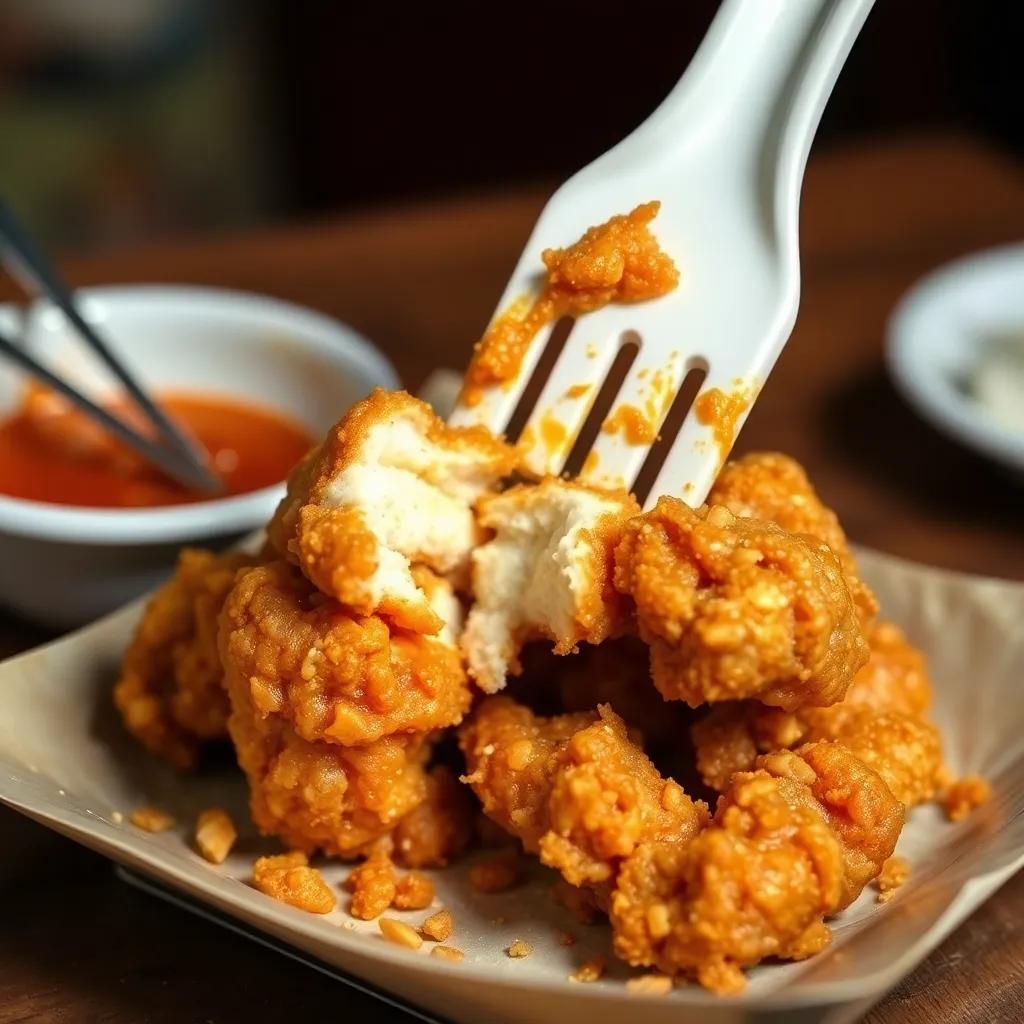
Ingredient Notes
A few key ingredients elevate this crispy Korean fried chicken from ordinary to unforgettable, each bringing its own magic to the overall flavor and texture.
Gochujang (Korean Chili Paste): This quintessential Korean staple is the heart of the sauce’s complex flavor. Made from fermented chili peppers, glutinous rice, and soybeans, gochujang offers a perfect blend of spicy, sweet, and umami notes. When shopping, look for a paste that’s vibrant red with a thick consistency—authentic brands from Korea will often display Hangul on the label. If you can’t find gochujang locally, a mix of miso paste, chili powder, and a touch of honey can work as a substitute, but expect a mild difference in depth and fermentation flavor.
Cornstarch: While all-purpose flour provides structure, cornstarch is the secret weapon behind that ultra-crisp, light crust that Korean fried chicken is famous for. It helps absorb moisture and creates a delicate barrier that fries up wonderfully crunchy without becoming heavy or greasy. For a gluten-free alternative, you can swap cornstarch with rice flour or potato starch, both lending excellent crispiness.
Rice Vinegar: Among the sauce components, rice vinegar adds the subtle tang that brightens and balances the sweet and savory layers. Its gentle acidity is less sharp than regular white vinegar, enhancing the complex flavors without overpowering them. If you don’t have rice vinegar on hand, a mild apple cider vinegar or white wine vinegar can be used, but reduce the quantity slightly to prevent too much tartness.
Sesame Oil: Just a tablespoon of toasted sesame oil infuses the sauce and finishing garnish with a warm, nutty aroma that’s unmistakably Korean. This fragrant oil works wonders in elevating the overall profile without making the dish oily. Be cautious when buying sesame oil—opt for the darker, toasted variety for more pronounced flavor. If unavailable, a small dash of toasted walnut or peanut oil can provide a similar nutty note.
Together, these ingredients create a harmonious balance—spicy heat, sweet sticky glaze, crisp coating, and fragrant finish—that makes Korean fried chicken a standout dish in any kitchen. Exploring authentic products or suitable alternatives ensures you capture the essence of the recipe, even if some items feel new or unfamiliar at first.
Tips & Variations
Mastering crispy Korean fried chicken is as much about technique and thoughtful tweaks as it is about following the recipe. Here are some pro-level tips and creative variations to help you customize this dish to your liking and dietary needs.
- Double Frying Is Key—but Temperature Matters: The secret to that iconic crunch lies in frying the chicken twice at different temperatures. The first fry cooks the meat through at a moderate heat (around 340°F/170°C), while the second blast at a higher temperature (375°F/190°C) crisps up the exterior perfectly. Using a thermometer ensures consistent oil temperature, preventing greasy or soggy results.
- Dry Your Chicken Thoroughly: Before coating, pat your chicken pieces dry with paper towels. Excess moisture creates steam during frying, which softens the crust instead of crisping it. For even better results, let the wings air-dry in the fridge, uncovered, for 30 minutes to an hour.
- Double Dredging for Maximum Crunch: To replicate restaurant-level crispiness, dip the chicken twice in the egg wash and flour-cornstarch mixture. This extra layer creates a thicker, sturdier crust that holds up beautifully to the sticky gochujang sauce.
- Customize the Sauce Heat Level: If you prefer milder flavors, reduce the amount of gochujang or swap in a sweet chili paste. For those who crave more heat, add a pinch of cayenne or a splash of Korean chili flakes (gochugaru) to intensify the spice without overshadowing the sauce’s sweetness and umami.
- Make It Gluten-Free: Replace all-purpose flour with a gluten-free blend or rice flour, and substitute soy sauce with tamari or a gluten-free soy alternative. Cornstarch naturally fits gluten-free diets, so no changes needed there. This swap maintains the crisp texture and rich flavors without compromise.
- Vegan Variation: For a plant-based twist, try using crispy tofu or cauliflower florets instead of chicken. Press extra-firm tofu to remove moisture, then coat and double-fry using the same technique. The sticky gochujang sauce works just as well on these alternatives and delivers the signature sticky, spicy punch.
- Alternate Protein Options: Want to mix it up? Try this method on boneless chicken thighs or tenders for easier eating. Fish fillets, like cod or catfish, can also be prepared similarly—adjust frying times to avoid overcooking.
- Add Texture and Garnishes: Toasted sesame seeds and chopped green onions are classic, but don’t be afraid to sprinkle crushed peanuts or finely diced fresh chilies for extra crunch and flavor contrast. A drizzle of creamy mayo or a squeeze of lime can add intriguing layers to your serving.
- Prep Ahead for Parties: You can fry the chicken one day in advance and keep it warm in a low oven (around 200°F/95°C) on a wire rack to maintain crispness. Toss in the sauce just before serving to preserve that perfect crunch.
- Experiment with Sauce Variations: Though the signature gochujang sauce is delicious, you can try swapping honey for brown sugar or maple syrup for a different sweetness angle. Adding a teaspoon of grated ginger or a splash of orange juice gives the sauce a refreshing zing and lift.
- Oil Choices: While vegetable oil is standard, you can use peanut or canola oil for frying, as they have high smoke points. Avoid olive oil due to its lower smoke point, which isn’t ideal for deep frying.
By keeping these tips and variations in mind, you can confidently tailor your crispy Korean fried chicken to match your taste preferences and dietary goals, ensuring every bite is irresistibly crunchy and flavorful.
Leftovers & Storage
Leftover Korean fried chicken can be just as delightful as when it’s freshly made—if stored and reheated properly. Because the hallmark of this dish is its famously crispy double-fried crust coated in sticky sauce, preserving that unique texture requires a bit of care.
To store your leftovers, start by letting the chicken cool completely at room temperature, but no longer than two hours to keep food safety in check. Transfer the pieces into an airtight container—glass or BPA-free plastic containers with tight-fitting lids work best to lock in freshness without trapping excess moisture. If you have parchment or paper towels, layer them at the bottom and between the chicken pieces to absorb excess oil and prevent sogginess.
In the refrigerator, properly stored Korean fried chicken will stay fresh and safe to eat for 3 to 4 days. When you’re ready to enjoy the leftovers, avoid microwaving directly, as it tends to make the crust chewy and mushy. Instead, reheat the chicken in an oven or air fryer at 350°F (175°C) for about 8 to 10 minutes, flipping halfway through. This method helps revive the crust’s crunch while warming the flavorful meat evenly. For smaller batches, a toaster oven does the trick as well.
If you want to keep your leftovers longer, freezing is an option—though with some texture trade-offs. Wrap pieces individually in plastic wrap or foil, then place them in a freezer-safe zip-top bag or container. Frozen Korean fried chicken will maintain best quality for up to 2 months. To thaw, move the chicken to the fridge overnight and reheat gently in the oven to restore some crispiness.
This recipe also lends itself well to meal prep. You can prepare and fry the chicken ahead of time, store it without sauce, and add the gochujang glaze fresh just before serving. This keeps the coating crisp and the flavors bright. When packing for lunches, keep sauce and chicken separate to avoid sogginess during transit, then toss or dip right before eating.
With these storage and reheating tips, you’ll extend the joy of crispy Korean fried chicken beyond the initial meal, making it a convenient and crave-worthy option for next-day indulgence or quick homemade snacking.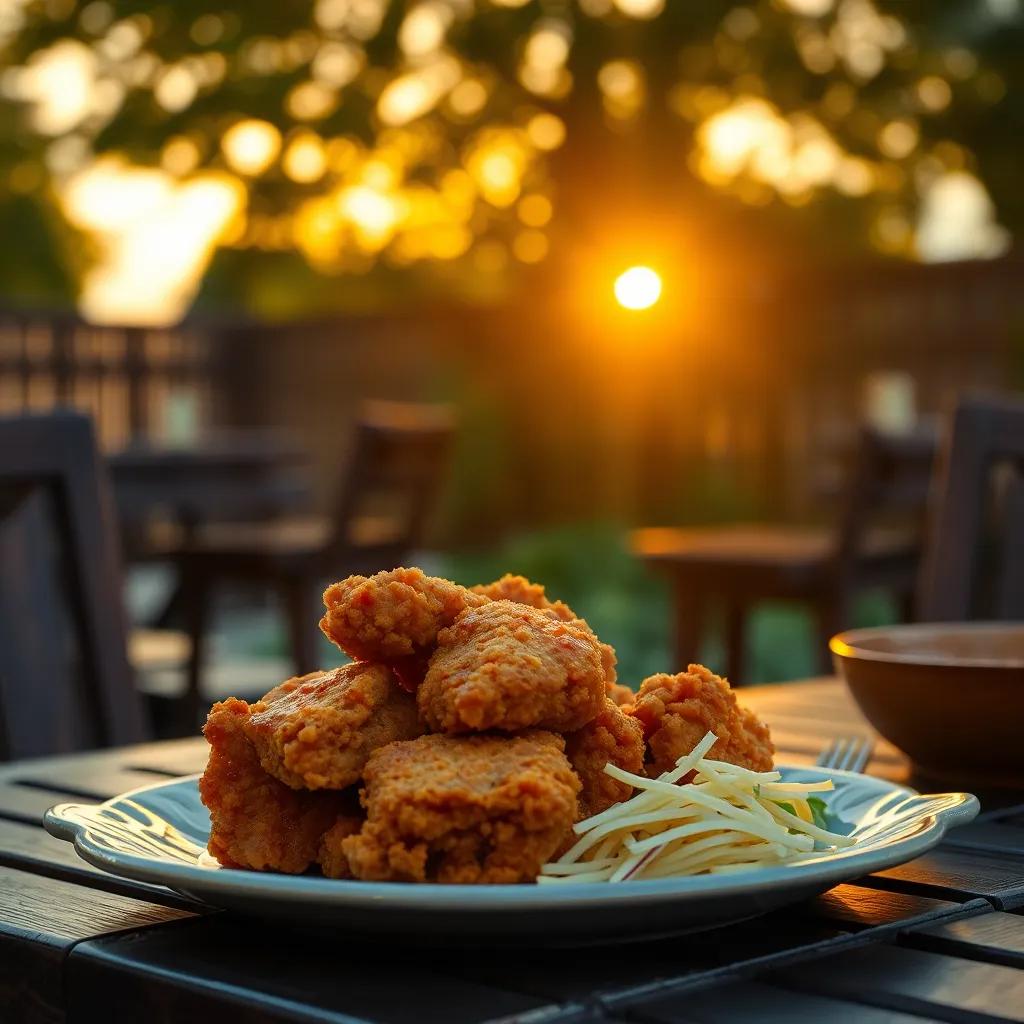
Behind the Recipe
Korean fried chicken, or “yangnyeom chicken” when sauced, has a fascinating story that goes beyond its irresistibly crispy crust and vibrant flavors. The roots of this dish trace back to the post-Korean War era, when American military bases introduced the concept of fried chicken to Korea. Over time, Korean cooks reimagined the classic fried chicken with local ingredients and techniques, resulting in the lighter, crispier, and twice-fried version that has captured global attention.
The hallmark double-frying method came about as a clever solution to the common problem of soggy, oil-soaked fried foods. By frying the chicken once at a lower temperature to cook it through, then again at a higher heat to create a golden, crackling exterior, Korean chefs achieved a unique texture balance unheard of in traditional fried chicken recipes. This technique not only locks in juiciness but also delivers an addictive crunch that stays longer after cooking.
The sauce—often built around gochujang, sweet honey, and tangy rice vinegar—is an artful fusion of sweet, spicy, and umami flavors that has become synonymous with Korean cuisine’s rich flavor profiles. Each family or region can have its own take on the glaze, reflecting local tastes and ingredient availability, which makes the dish invitingly versatile.
On a personal note, many home cooks and enthusiasts find joy in the ritual of making Korean fried chicken. The process is almost meditative: mixing the batter, carefully monitoring oil temperature, and the satisfying moment when the sauce perfectly coats the pieces. Sharing a platter of them feels more than just a meal—it’s a communal experience that brings people together, whether during casual weeknights or celebrations.
This recipe, while approachable for home kitchens, pays homage to this culinary evolution—a blend of history, ingenuity, and flavor—allowing you to recreate a beloved Korean classic with authenticity and ease. It’s a testament to how a simple concept, transformed through cultural exchange and innovation, can become a globally cherished comfort food.
FAQ
Can I make this recipe gluten-free?
What’s the best way to keep the chicken crispy when reheating?
Can I use something other than chicken for this recipe?
How do I store leftovers to maintain freshness?
Is it okay to prepare the chicken ahead of time?
Can I adjust the sauce if I want it less spicy or sweeter?
What oil is best for frying Korean chicken?
Wrapping It Up
There’s something undeniably satisfying about biting into crispy, golden Korean fried chicken that’s perfectly juicy inside—a true harmony of texture and flavor that’s easier to achieve at home than you might think. With this simple guide, you’re just a few steps away from creating a mouthwatering dish that’s sure to impress family and friends alike.
Now it’s your turn to bring this recipe to life! Give it a try, and don’t forget to share how it went in the comments below. Whether you’ve got a secret ingredient or a creative twist, we’d love to hear your take—and if you enjoyed the recipe, a rating would be the cherry on top! Happy cooking!


